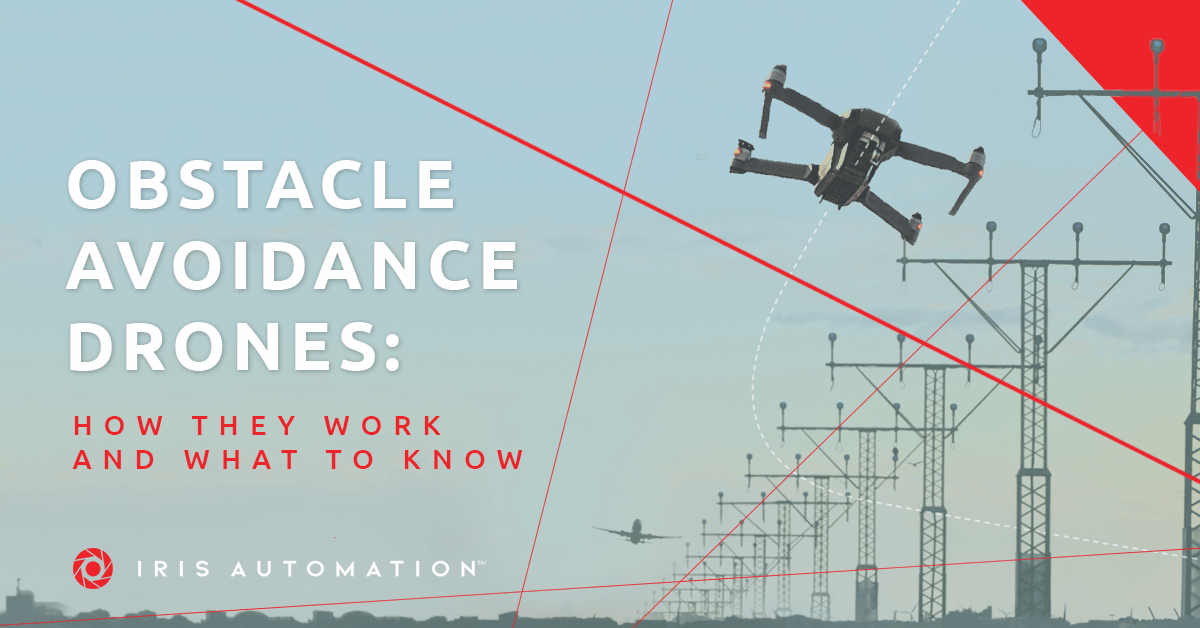by Alejandro Galindo, VP of Research & Development at Iris Automation
What is obstacle avoidance?
Drones currently on the market with ‘obstacle avoidance’ features are able to maneuver around static objects, such as buildings, mountains, and trees without being manually piloted to do so. Static object avoidance is a problem that has been worked on for many years, and is mainly included in hobbyist drones, by manufacturers such as DJI, Walkera, Yuneec, and Skydio. But obstacle avoidance has a limited scope of use. Since the drone can only ‘see’ 10-100 feet away, it severely limits how fast the drone is able to fly while maintaining the ability to avoid obstacles.
Obstacle avoidance features are much less common on larger drones like the ones used for commercial operations, because those drones fly higher in the sky where they’re less likely to encounter static obstacles and more likely to encounter dynamic obstacles, as well as flying faster; the solutions for static obstacle avoidance on the market do not satisfy those needs. So obstacle avoidance typically remains in the realm of smaller drones, for both hobbyists and smaller scale operations, such as thermal inspection and hazard detection inside of warehouses and close inspection of wind turbines and power lines.
The requirements on the performance of Detect-and-Avoid capabilities for dynamic objects vary because sometimes the risks can be mitigated with infrastructure masking. The basis for infrastructure masking is the Specific Operational Risk Assessment (SORA), an international standard for evaluating the risks of BVLOS and other complex operations. They define the lowest class of air risk as “atypical airspace,” which has a broader definition, but typically refers to airspace where normal manned aircraft cannot go, i.e. within 100 feet of infrastructure. For example, when you fly close to buildings or in a deep valley, you have an extra layer of safety because manned aviation is less likely to be flying in the same airspace. Similarly, infrastructure shadowing is flying alongside the exact altitude of the structure, i.e. a power line within 50 feet to “shadow it.” This is higher mitigation than just masking as you’re more unlikely to encounter any manned aircraft.
Additionally, when a drone flies high enough to reach national airspace, the FAA and other Civil Aviation Authorities (CAA) worldwide have strict requirements regarding safety and flying Beyond Visual Line of Sight (BVLOS). In the United States, CFR Part 107.37 requires that small unmanned aircraft yield right of way and stay well clear of other aircraft (no waivers are permitted to get past this). CFR 91.113 requires that Unmanned Aerial Systems (UAS) remain within the unaided visual line of sight of the pilot, but it is possible to obtain a waiver to enable BVLOS flight (check out our article A Detailed Walk-Through of How to Obtain a BVLOS Waiver).
Detect-and-Avoid vs obstacle avoidance
While obstacle avoidance drones are able to maneuver for collision avoidance with static infrastructure, Detect-and-Avoid (DAA) capability allows UAS to fly at any speed and to take avoidance maneuvers whenever dynamic obstacles appear in the airspace surrounding it.
Dynamic obstacles include manned and unmanned aircraft and potentially birds. In order to successfully avoid a manned aircraft or other dynamic flying object, DAA systems need to be able to detect that object from much farther away than an obstacle avoidance drone is able to, around 4000 feet, so that it is not only possible to avoid it, but to keep a safe distance at all times.
While there are established techniques on how to sense and avoid static objects such as simultaneous localization and mapping (SLAM), and sonar- and lidar-based solutions, the challenge for drone manufacturers comes from integrating these into an airborne solution, so that it works in real-time while flying at cruise speeds. Dynamic obstacle avoidance while flying hasn’t been successfully addressed for small UAS until recently (by Iris Automation), so the challenge is even bigger. Because drones are now able to fly very long distances through and above rough geographies, an airborne solution is usually preferred from a cost, operations, and scalability perspective.
Requiring drones to have Detect-and Avoid capability allows for the safe integration into the national airspace of autonomous drones flying Beyond Visual Line of Sight (BVLOS) alongside manned aircraft. In this integration of aircraft, it is important for the drone to have a dynamic situational awareness, because not everything can be predicted or planned for.
Why fly Beyond Visual Line of Sight (BVLOS)?
Applications are limitless when autonomous drones are able to avoid both static and dynamic obstacles, including package delivery, infrastructure and pipeline inspections, and search and rescue, to name just a few. And there are a multitude of use cases yet to be discovered. Types of sensors used for detection can be found in our article on Drone Sensors. The most common ones include acoustic for short distances, and electro-optical and radar for long distances.
Drones that avoid dynamic objects are not commercially available right now, and this is why Iris has developed Casia, a product that any drone manufacturer is able to put on their Unmanned Aerial Vehicle (UAV) for onboard dynamic obstacle detection and avoidance. Casia is an onboard Detect-and-Avoid solution that uses industrial cameras and Computer Vision to observe and interpret the world for full situational awareness of the operational environment, detecting and identifying dynamic obstacles and determining the need to take an avoidance maneuver.
Click here for more information on our Detect-and-Avoid solution, Casia.
Sources:
https://www.faa.gov/documentLibrary/media/Advisory_Circular/AC_107-2.pdf

